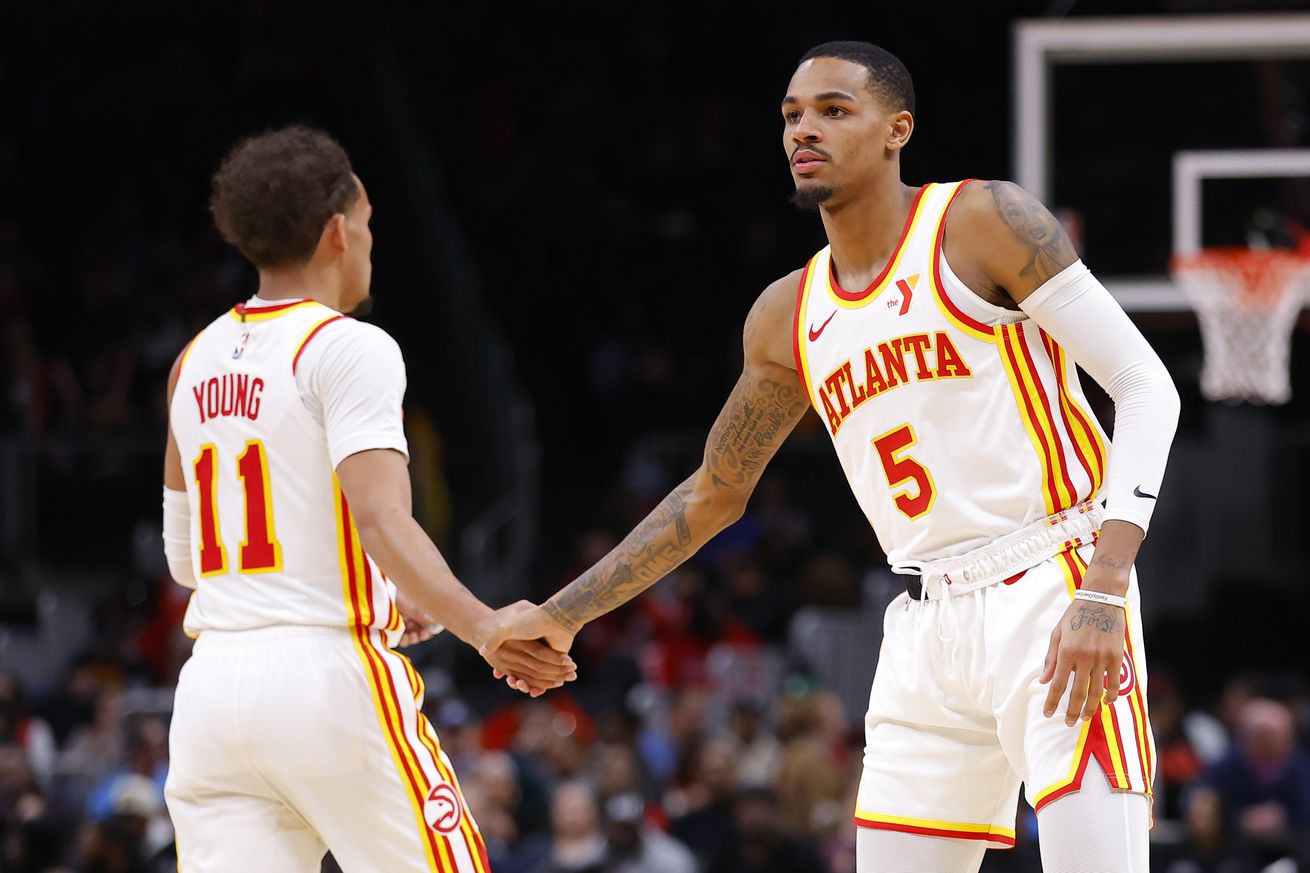
This is the final part of the three-part series where I’ve written about the rotation players in each of the Hawks’ positional groupings this season and highlight a few interesting statistics I came across in my research. I hope you’ve enjoyed reading them, I’ve had a ton of fun writing them.
Editor’s note: Part 1 (forwards) and Part 2 (centers) of this series can be find at the links.
Without further ado, let’s dig into how Dejounte Murray, Trae Young and Bogdan Bogdanovic have been performing so far this season.
Dejounte Murray: Shooting Just 59% At The Rim (7% Lower Than Last Season)
Dejounte Murray’s second season in Atlanta has been a strange one to say the least. Starting over the summer, amid murmurs that the team was dangling him in trade talks for former Raptor and current Pacer, Pascal Siakam, the 27-year-old signed a 4-year, $114 million contract extension with the Hawks — seemingly putting an end to the speculation surrounding his future as he would be ineligible to be traded until January 9th upon signing the extension.
When the news broke, Murray tweeted out “Loyalty over Everything… #TrueToAtlanta” which was seen as a sign of optimism amongst Hawks’ faithful; a message to the fanbase that while his first season in Atlanta might not have gone too smoothly, he had bought into the team, and trusted the vision laid out for him by the front office and new head coach, Quin Snyder.
Six months later, the Hawks find themselves eight games below .500, sitting in 10th place in the Eastern Conference. Their offense, which ranked seventh last season, is down to 14th this season. Their defense (which has finished no better than 18th over the past six seasons) is ranked 27th. They’re being outscored by three points per 100 possessions, and their net-rating stands as the seventh worst mark in the league.
If we zoom in on the month of January alone, the Hawks have the 23rd ranked offense, the 27th ranked defense, and have been outscored by 8.4 points per 100 possessions — the third worst mark in the league this month.
Unfortunately, Atlanta has hardly looked like a team that’s capable of winning a Play-In game, much less a Playoff series at the 46-game mark of the 2023-24 season, and in turn, Murray — being Atlanta’s best trade asset — has emerged as one of the league’s hottest trade candidates just 18 months after the team traded three first-round draft picks* to acquire him from the Spurs.
*none of which have conveyed yet
Life moves fast.
Still, is it really in Atlanta’s best interest to move on from Murray? Murray has appeared in 45 out of Atlanta’s 46 games so far, but how big of a role has he played in this less-than-spectacular Hawks’ season?
Let’s begin on the defensive end. Murray led the NBA in both steals and deflections during his final season in San Antonio. And it’s good to see that this activity has translated to his time with the Hawks as he finished sixth in steals and fifth in deflections last season, and ranks 13th in steals and third in deflections so far this season. Still, Murray’s on/off defensive impact hasn’t been very impressive, and I found it interesting that the Hawks have actually forced fewer turnovers with Murray on the floor* over the past two seasons, per cleaningtheglass.

Atlanta allowed 116 points per 100 possessions with Murray on the floor last season, and is currently allowing 120.9 points per 100 possessions with him in the game so far this season — a figure which ranks in the 20th percentile relative to all 5-man lineups who have logged at least 100 possessions this season.
These lineups are allowing opponent’s to take 37% of field-goal attempts at the rim (13th percentile), and shoot 39.3% from three (21st percentile), per cleaningtheglass, two numbers that point to a shoddy perimeter defense — and Murray is no exception.
Moving onto the offensive end, though Murray is averaging career-highs in points (21.4) and three-point attempts (6.2), while shooting an impressive 38.7% from three, I wouldn’t go so far as to call him an efficient offensive player. Murray’s effective field goal percentage (53.7%*) ranks just 105th out of the 166 players who have appeared in at least 25 games and have played at least 24 minutes per game this season.
*also a career-high
We know that part of the reason this number is so low is because Murray is not afraid to let it fly from the mid-range, taking 41% of his field-goal attempts from between four feet of the basket and the three-point line*. However the biggest contributor to Murray’s less than impressive shooting efficiency this season has been the fact that he is shooting just 59% at the rim, a figure which ranks in just the 36th percentile amongst combo guards per cleaningtheglass and is 7% worse than his mark from last season, when he ranked in the 72nd percentile amongst all combo guards.
*An improvement from his sky-high, 52% mid-range frequency last season, and it’s nice to see that he’s knocking them down at a career-best, 48% clip so far this season. That being said, on a pure points-per-shot basis, the majority of these are simply not efficient shot-attempts.
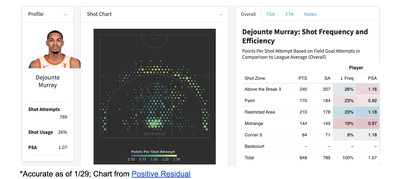
I imagine that Murray playing 68% of his minutes alongside Clint Capela this season* — who tends to position himself around the basket on offense — compared to just 50.4% of his minutes last season has a bit to do with this sudden, dramatic drop off in rim-shoot efficiency. However, some of his misses have just been uncharacteristically strange.
*Per cleaningtheglass, Murray/Capela lineups are shooting just 58.7% at the rim (6th percentile) in 2,264 possessions, while lineups with Murray on and Capela off are shooting a slightly more palatable 63.5% at the rim (31st percentile) in 1,046 possessions.
This one from a game against the Rockets back in December is just a head scratcher.
From the Cavs game earlier this month, Murray gets past Donovan Mitchell and has an open path to the basket, but just can’t convert the lefty finish.
This miss against the Heat is another weird one. Perhaps he anticipated a harder contest from Bam Adebayo?
Some of his misses (and not just the ones at the rim) come down to his shot selection, which has been quite poor this season as well.
Take a look at this late game possession from an overtime loss to Orlando earlier this month. Atlanta was coming off of a (rare) good defensive possession, where they forced a miss from Paolo Banchero to keep the Magic lead at five points with under a minute left to play. When Murray crosses half-court, there are 39 seconds on the game clock, and he is the only Hawks in the front-court. Yet he opts to put his head down, take on two defenders by himself, and chuck up a wild shot. Orlando would secure the rebound, and seal the victory at the free throw line on the following possession.
Irrespective of whether or not the Hawks wanted to go “two-for-one,” it would’ve been nice to get a cleaner look at the basket in such a high stakes situation.
The possession below is from the Kings game a few weeks ago (which the Hawks eventually lost by seven). The Hawks push the pace after a miss by De’Aaron Fox, and as a result Clint Capela has a mismatch with Fox now guarding him. Murray crosses halfcourt and appears to make note of this advantage, then puts his head down, drives straight at Kevin Huerter, and forces up a tough contested floater.
With Murray on the ground, the Kings push the pace themselves on the following possession, and eventually get an open three for Huerter that he splashes.
In an alternate universe, Murray swings the ball to Jalen Johnson, potentially forcing Sabonis to close out on him so that Atlanta can take advantage of the mismatch for their center.
This is another ‘head down’ possession from Murray from a different game against the Magic this month.
Murray would go on to hit the game-winner in this one, but still, it’s a 48-minute game, and the extent to which he is forcing things on offense is evident on this possession, as there were 10 seconds left on the shot clock when he opted to take a contested floater over two defenders.
Murray’s assist to usage ratio (0.86) this season is the lowest mark of his career, and ranks in the 32nd percentile amongst combo guards, per cleaningtheglass. He’s also averaging the second-fewest assists per 100 possessions of his career.
The ball tends to stick a little more when Murray is in the game, and plays like the ones above are a big part of the reason why.
Trae Young: Young’s effective field goal percentage ranks 144th out of 168 qualified players*
*players who have appeared in at least 25 games and have played at least 24 minutes per game this season
Though the “watchability” of his playstyle can be debated, Trae Young has established himself as one of the league’s premier offensive forces ever since setting foot in the league five and a half seasons ago.
Few players orchestrate their team’s offense to the extent that Young has during his time in Atlanta, and only he and Luka Dončić have had an offensive load percentage* north of 60% in each of the past four seasons. The fact that Atlanta’s offense has ranked in the top-10 in each of the past 3 seasons is a credit to Young’s effectiveness as an offensive hub.
*Offensive Load Percentage is a metric created by Thinking Basketball’s, Ben Taylor, which estimates how much a player contributes to an individual possession through their shooting, creating, passing, and turning the ball over. This is, in my opinion, a more comprehensive version of the traditional “Usage Rate” metric because Usage Rate only factors in how often a player shoots and turns the ball over, while Offensive Load Percentage takes into account creation and passing as well. If you’re interested, you can read more about Offensive Load here.
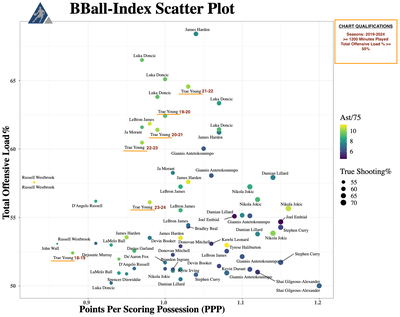
Though this figure is down to 56% for Young this season, it still ranks as the third-highest offensive load in the league*, and it illustrates just how much of the team’s offense he continues to drive.
*Luka Doncic (61%), and Joel Embiid (59%) are the only players (with at least 1000 MP) who are ahead of Young in this category in 2023-24
We know that Young is an all-world passer, having never finished outside of the top-5 in “high value” assists per 75 possessions since he entered the league. His 10.8 assists per game this season is a career-high and is good for second in the NBA behind Tyrese Haliburton. However, the area of Young’s game that I’d like to focus on today is the volume and efficiency at which he shoots.
While Young is averaging 27 points per game this season (10th in the NBA), when you consider how much he has the ball in his hands, as well the fact that he isn’t a particularly efficient scorer, this number begins to lose its sheen.
Looking at his shooting frequency and accuracy tables below, you can see that outside of the 2021-22 season, Young’s effective field goal percentage has ranked average to below-average relative to other point guards, and that he has never been a particularly efficient shooter from beyond the three-point line.


While Young has upped his three-point attempt rate this season, his effective field goal percentage (50.7%) ranks just 144th out of the 168 players who have appeared in at least 25 games and have played at least 24 minutes per game, and that is exacerbated by the fact that he ranks seventh in the league in field-goal attempts per game.
It’s tough to blame this figure on shot quality too, as Young takes more “wide-open” field goal attempts* than anyone else in the league, and a lot of his shots are clean looks that just don’t go down.
*field-goal attempts with no defender within 6-feet of the shooter
*It’s great see Young being used as a screener here, however he wasn’t able to knock down the open three.
*This is terrific off-ball movement from Young.
*This is another good shot that Young just couldn’t get to fall.
That being said, there have also been instances where Young makes life harder on himself by fishing for a foul call instead of trying to create a high percentage look for himself or a teammate.
Take a look at the following possession from a game against the Bulls. Young collapses Chicago’s defense, but instead of kicking it out to a teammate, he forces up a tough floater then gestures to the referee for a foul call instead of hustling back on defense.
On this possession against Miami, he gets past Caleb Martin, then tries to jump back into Martin to draw contact — a maneuver that Martin sees coming — and misses the 11-footer.
Drawing fouls is a staple of Young’s game. He has finished in the top-10 in free throw attempts ever since his rookie year. Still, foul hunting is not a go-to offensive strategy. Possessions like the ones above hurt the offense, and simply have to become a lesser part of his game.
In my opinion, part of the reason behind Young’s tendency to hunt for fouls comes down to his mediocre efficiency as an isolation scorer. Young ranks 14th in total isolation possessions this season, yet is scoring just 0.95 points-per-possession on these plays — which places him in just the 52nd percentile in isolation efficiency amongst all players*.
*This figure isn’t an anomaly either. Last season, Young ranked 13th in total isolation possessions and scored just 0.94 ppp (55th percentile)
Here he gets past Miles Turner, but can’t convert the finish in traffic.
On this possession he gets past Nic Batum on the perimeter, but is unable to convert the finger roll.
Young is an intelligent basketball player, and logically, if he doesn’t believe that he’s in a position to score, then the next best thing to do would be to draw a foul.
Another crucial element in the plays above (and specifically the misses at the rim), is how often Young ends up on the floor and/or out of the play after a miss, leaving his team at a significant disadvantage on the defensive end.

As you can see from the table above, Atlanta’s transition defense really suffers with Young in the game, as Hawks’ opponents are turning a whopping 37% of their live defensive rebounds into transition opportunities (fourth percentile)* and are scoring 1.3 points-per-possession (26th percentile) on these plays so far this season.
*an increase of nearly 10% compared to when Young is on the bench – a major problem
Young has been praised for his improved effort on defense this season, and while the Hawks are allowing a respectable 1 point per possession in the half-court with him on the floor, they are being blitzed in transition during his minutes which destroys their defensive rating.
Though Young isn’t the only player guilty of plays like this, he certainly shoots the most (as we’ve discussed), and it’s imperative for him to both take smarter shots and stay on his feet on the offensive end so that he doesn’t compromise the team’s defense.
Murray + Trae Young Partnership (Bonus): Atlanta Has Been Outscored By 5.3 pts/100 possessions With Dejounte Murray and Trae Young On The Floor
Looking at how the Dejounte Murray/Trae Young partnership has fared this season, after a good-but-not-great first season, things have deteriorated on both ends of the floor in year two. Murray/Young lineups outscored their opponents by 1.6 points per 100 possessions last season, yet this season, these lineups have been outscored by 5.3 points per 100 possessions.
It should be no surprise that the defense has been a disaster for these units, as they are allowing opponents to take a whopping 39.2% of their field goal attempts at the rim*, and are being killed in transition. What’s more concerning to me is that on the offensive end, these lineups are scoring fewer points per 100 possessions than last year, and are performing at just a league average rate this season.
*which ranks in the 2nd percentile relative to all 5-man lineups with at least 100 possessions played, per CTG.
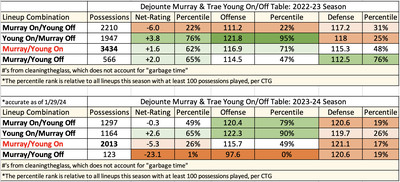
It’s important to note that it’s more common for just one of Young or Murray to be on the floor when both team’s bench units are on the court*, but 1000+ possessions is still far from a small sample size. And it’s less than ideal for Atlanta’s offense to be performing better when one of their two most talented offensive players is sitting on the bench this season.
*As discussed later on in this piece as well as in the one focused on Atlanta’s centers, Bogdan Bogdanovic and Onyeka Okongwu’s offensive impact off the bench has been invaluable for the Hawks this season
A big reason behind the Young/Murray lineups’ mediocre offensive rating comes down to the redundancy in their play-styles. If we take a look at the duo’s scoring play types over the past three seasons, the similarities between them, as well as their lack of adaptation after they joined forces is evident.
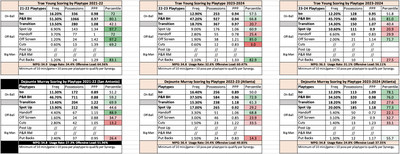
Through one and a half seasons, it’s become obvious that both players are much more comfortable operating with the ball in their hands — as you can glean from the table above.
In Murray’s case, though his efficiency on spot-up attempts has taken a big leap this year, he is bizarrely shooting just 31.4% (16-for-51) on “wide open” three-pointers*, which subverts his status as a reliable catch-and-shoot threat.
*three-point attempts with no defender within 6-feet of the shooter
In Young’s case, his efficiency on spot-up looks has fallen off a cliff, and he is shooting just 35.2% (31-for-88) on catch-and-shoot three-pointers — which ranks 176th out of the 255 players who have taken at least 50 catch-and-shoot threes this season and subverts his status as a reliable catch-and-shoot threat.
While both players are, to their credit, running more off-ball actions than they were last year, it hasn’t been enough, and there is still far too much iso-ball/ball-watching going on when they share the court, resulting in possessions ending like this:
Or this:
Things have looked especially bad in recent weeks, as Saddiq Bey and Jalen Johnson have respectively shot just 23.3%, and 33.3% from three in the month of January. Adding in the fact that Clint Capela has never been much of a threat from outside the restricted area, the Hawks have zero reliable catch-and-shoot threats in their starting five at the moment — kryptonite for any offense, but particularly one that’s as reliant on the pick-and-roll as Atlanta’s.
This five-man lineup (Young, Murray, Bey, Johnson, Capela) has been the Hawks’ most frequently used lineup this season, yet due to their outside shooting woes, they have managed to score just 102.2 points per 100 possessions* when they have been on the court together this month.
*For reference, the Memphis Grizzlies are owners of the worst offense in the league this season, scoring 107.8 points/100 possessions
All in all, It’s been tough sledding for the Murray/Young partnership in year two, and barring a sudden improvement in perimeter defense, three-point shooting, and/or off-ball movement, it’s tough to see things changing over the second half of the season.
While getting De’Andre Hunter back (potentially today!) should help a little, a change of scenery for one of Murray or Young could be what’s needed in order to get the best out of both players.
Bogdan Bogdanovic: Shooting 43% on Three-Point Attempts When the Closest Defender is 4+ Feet Away
In a season full of doom and gloom, Bogdan Bogdanovic has been a rare bright spot for the Atlanta Hawks. In just over 28 minutes a night off the bench, “Bogi” is averaging 17.1 points*, 3.1 rebounds, 2.6 assists and 1.4 steals* this season, while shooting 36.9% from downtown on 8.4 three-point attempts* per game.
*Indicates a career-high
Though his raw three-point shooting percentage this season is just around league average (36.7%), and may seem underwhelming, this figure begins to look more impressive when you consider the quality of his three-point attempts, as well as the volume at which he is taking them.

Bogdanovic ranks second in the league total catch-and-shoot three-point attempts this season and ninth in the league in total three-point attempts. From the table above, you can see that when afforded the space, he has been a knockdown perimeter shooter — converting 43% of his triples with the closest defender four feet away or further.
That being said, he ranks second in the league in “tightly contested” three-point attempts, with nearly a third of his three-point attempts coming with a defender within two to four feet, and his field goal percentage on these looks (24%) ranks last out of the 15 players who have taken at least 65 “tightly contested” threes this season. While the last thing we want is for Bogdanovic to shoot less, it would be great to see him get some cleaner looks from beyond the arc as he is converting these at a much higher rate.
Because Bogdanovic is primarily a catch-and-shoot threat, the two biggest factors in the quality of his three-point attempts are his teammates’ ability to draw the defense’s attention away from him as well as intelligent play design.
In this possession from Sunday night’s game against the Raptors, the defense throws two defenders at Trae Young, so Jalen Johnson cuts to the free throw line, forcing Jordan Nwora to help way too far off of Bogi. Young quickly gets it to Johnson who takes a dribble then whips a pass over to Bogdanovic in the opposite corner, and it’s three points for the Hawks.
In this possession from Friday’s game against the Mavericks, Richaun Holmes is in drop coverage, so when Okongwu sets the screen, it’s Bogdanovic’s man who has to pick up Trae Young while Derrick Jones Jr. fights over the screen. After his man helps, Bogdanovic knows he is uncovered, so makes a beeline towards the opposite wing. Trae Young spots him, and it’s an open three-pointer for Bogi.
It would be great to see the Hawks’ involve him some more in off-ball actions like they do in the play above to try and get him a few more open looks.
Per cleaningtheglass, Bogi’s on/off efficiency differential (+12.3) ranks in the 96th percentile amongst all players, and is (by far) the highest figure on the team. While Atlanta’s defensive rating improves by an impressive 3.7 points/100 possessions with him on the court, it should be no surprise that the majority of his impact comes on the offensive end, as the Hawks are taking significantly more threes, and are shooting much better from three with Bogdanovic in the game.
*Atlanta is a +59 in Bogi’s 1,255 minutes played this season. Only him and Bruno Fernando have a positive plus-minus for the Hawks this season


Simply put, Bogdanovic has been invaluable for the Hawks this season.
Keep on shooting, Bogi!
Disclaimer: All stats used in this article are from either nba.com/stats, basketball-index.com, basketballreference.com, or cleaningtheglass.com.
